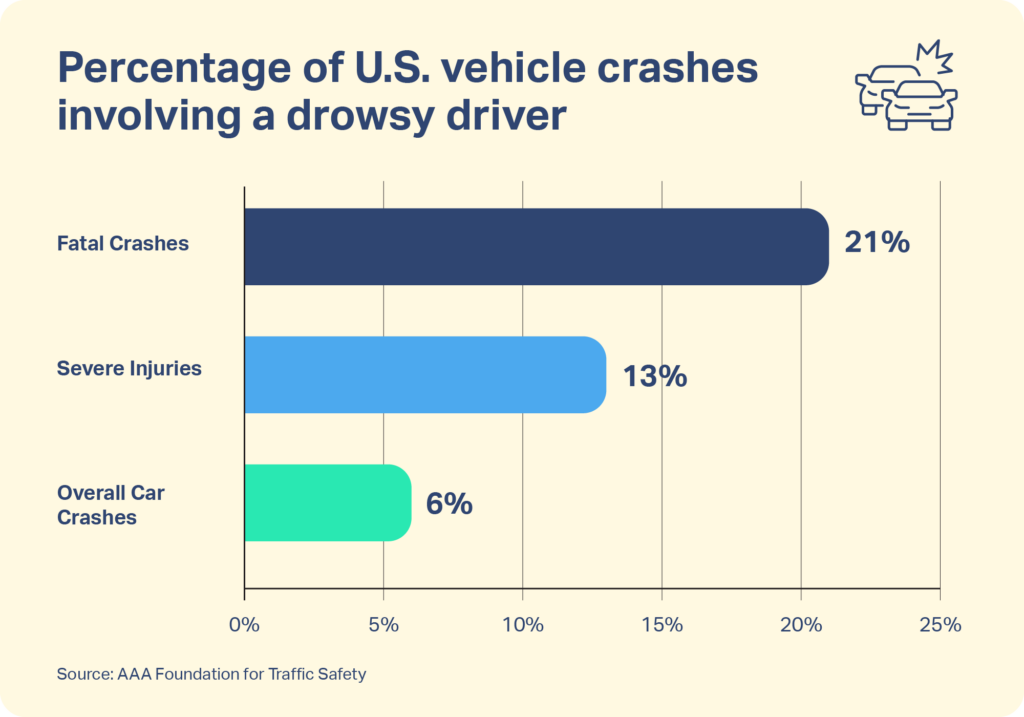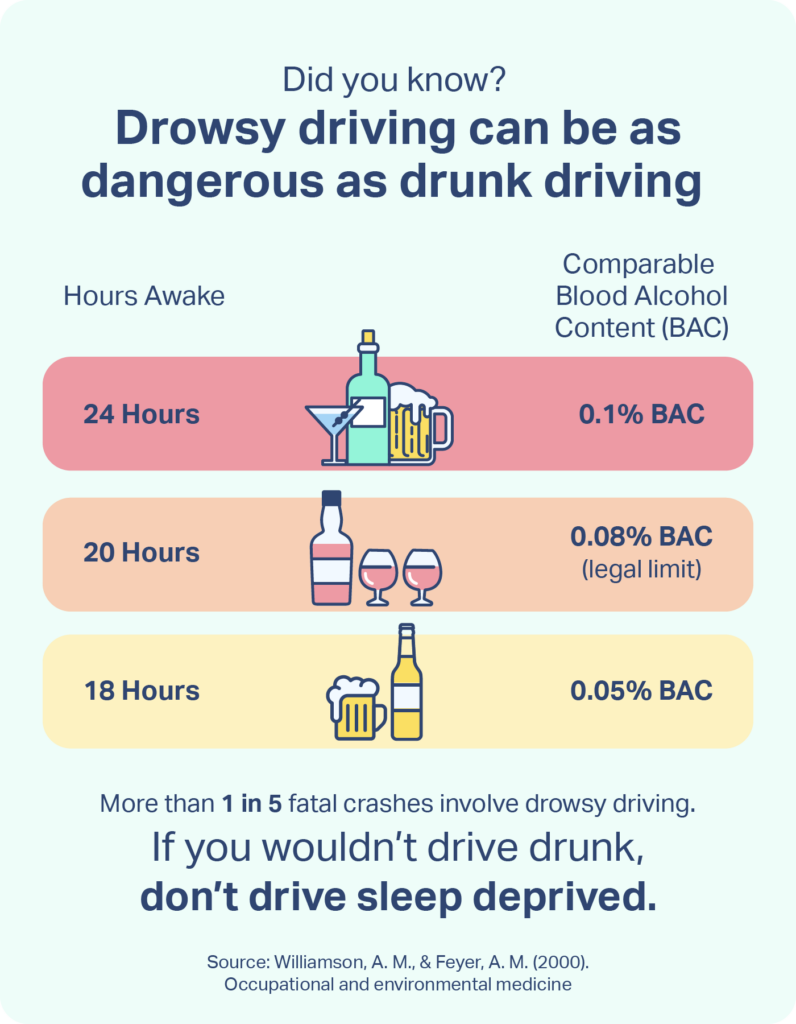“Up to that point, I had been tired when driving, but had never fallen asleep before, and I definitely hadn’t done that with my baby in the car,” she says. “I narrowly avoided a collision and I had the feeling that I could’ve just died.”
Shortly after, Cooksey was diagnosed with sleep apnea and began treatments that significantly reduced her symptoms, including daytime sleepiness. Though she’s never come close to nodding off on the road again, she never forgot the incident. The 46-year-old Florida resident, writer, and podcast host has since devoted her career to advocating for people with chronic sleep issues.
“What fuels my advocacy for other patients is the thought that there are so many drowsy drivers with undiagnosed sleep disorders who are not as lucky as I was and who never wake up,” she says.
Drowsy Driving Prevention Week®, an annual campaign launched by the National Sleep Foundation (NSF), is observed the first full week in November and will be held this year from November 5-11. It’s a great time to consider how you can spread the word by encouraging people you know to exercise caution and do what they can to mitigate their own risk.
An Underrated Public Health Issue
Compared to drunk driving or even distracted driving, drowsy driving is not discussed on a wide scale with nearly the same level of urgency. Tired driving is also, arguably, more challenging to prevent. People can’t always ensure they’ll sleep well at night, and they may fear they’ll face penalties at work if they choose not to drive. Therefore, it is all the more critical to address the issue on a societal level.

Only two states, Arkansas and New Jersey, currently have laws that criminalize driving while fatigued if you cause a crash in which someone is killed. But the effectiveness of these laws has not been well studied. According to the National Highway Traffic Safety Administration (NHTSA), “It is likely that these laws will have little or no effect unless they are vigorously publicized and enforced.”
Companies that employ commercial drivers must adhere to federal regulations that limit how long a driver can be on the road. For instance, drivers of passenger-carrying vehicles may only drive for up to 10 hours in a row after 8 consecutive hours off duty.
“What fuels my advocacy for other patients is the thought that there are so many drowsy drivers with undiagnosed sleep disorders who are not as lucky as I was and who never wake up.”
Emma Cooksey, sleep disorder patient advocate
The NHTSA urges states to take the issue more seriously, and many states are attempting to do so, with designated days or weeks for raising awareness similar to the National Sleep Foundation’s campaign.
With the holiday season approaching, many people are planning long drives. Last year, AAA estimated that 48.7 million traveled by car over the Thanksgiving holiday alone. Vigilance against drowsy driving is even more crucial during this time.
Drowsy Driving: Beliefs Versus Reality
Surveys indicate that Americans are well aware that drowsy driving is wrong. In a 2021 survey by the AAA Foundation for Traffic Safety, the vast majority of respondents (94.8%) said that drowsy driving is very or extremely dangerous.What’s more, they recognize this as a widely-held belief: 76.5% of respondents said they believe that people important to them would thoroughly disapprove of them driving if respondents were so tired that they struggled to keep their eyes open.
Although survey respondents perceived sleepy driving as one of the greatest driving risks–second only to driving under the influence of alcohol and prescription drugs and about on par with driving after using marijuana–our beliefs don’t always line up with our behavior. About one-fifth of respondents (19%) admitted to driving while very drowsy at least once in the past 30 days.
And while drivers may be aware when they are drowsy, they often don’t realize just how sleepy they are, according to 2023 AAA Foundation research. Three-quarters of drivers who thought they were only mildly tired were, in fact, moderately or severely sleepy. And even when drivers realized they were fatigued, 75% decided to keep driving rather than take a break.
Alex Knobloch, a 49-year-old writer based in Minnesota, says he’s never fallen asleep behind the wheel, but he got close once. “Right before, you have this moment when you still have your eyes open, but you just feel like you’re not in control anymore,” he says. “It’s pretty scary because I have kids and I wanted to get home safe. Since then, I’m really, really careful. I try to avoid any situation where this could happen.”

The Perils of Drowsy Driving
Drowsy drivers were involved in 91,000 police-reported crashes in 2017. These incidents resulted in injuries for an estimated 50,000 people and killed nearly 800.
Occasionally, these tragedies make the news, such as when a commercial truck driver who’d been awake for more than 28 hours crashed into a limo that held comedians Tracy Morgan and James “Jimmy Mack” McNair, resulting in the latter’s death. But many accidents involving tired drivers aren’t publicized, and the actual number is likely much higher than official reports show.
Unlike drunk driving, where blood alcohol concentration (BAC) can be measured, drowsy driving crash statistics rely on interviews with drivers who may not realize or admit they were sleepy and reports from crash investigators who look for clues to help determine the cause. These clues are not always easily recognized or definitive.

“It’s hard to know how many accidents are actually caused by people who are sleepy,” says Dr. Dustin Cotliar, a board-certified emergency medicine physician and sleep expert. “Someone can get in a car accident without fully falling asleep. It’s possible they were drowsy and not as alert as they normally are, or maybe their reaction time was slower.”
Indeed, a 2018 survey by the AAA Foundation for Traffic Safety indicates that the percentage of crashes involving drowsy drivers is nearly eight times higher than federal estimates. A prior study by the same foundation found that there were more than 6,000 crashes per year involving a fatigued driver that resulted in at least one death and that more than one in five fatal car crashes involved a drowsy driver. That means drowsy driving ranks nearly as high as drunk driving on the list of reasons for crashes. About 31% of all traffic crash fatalities in the U.S. involve drunk drivers.
“It’s hard to know how many accidents are actually caused by people who are sleepy. Someone can get in a car accident without fully falling asleep. It’s possible they were drowsy and not as alert as they normally are, or maybe their reaction time was slower.”
Dr. James Cotliar, emergency medicine physician and sleep expert
In fact, the effects of tiredness can mirror intoxication. Being awake for 17 hours—say, if you woke at 6 a.m. and drove home at 11 p.m.— is similar to having a BAC of 0.05%. Sleepiness reduces reaction times, and even small reductions in reaction time can have a high effect on crash risk. At high speeds, there’s little room for error.
What Key Factors Lead to Drowsy Driving?
Sleep disorders
An estimated 50 to 70 million Americans have ongoing sleep disorders, such as insomnia and sleep apnea, all of which can contribute to drowsy driving. “If you have a sleep disorder, it may cause you to feel chronically sleep-deprived. You may be so used to feeling tired that you don’t even notice when you’re too exhausted to drive,” Dr. Cotliar says. You might even experience microsleep, a brief state of unconsciousness that may only last a few seconds but can be enough time to cause a crash.
Medications and sleep aids
As the Federal Drug Administration (FDA) warns, many medications can make driving dangerous, including opioid painkillers, prescription drugs for anxiety, sleep aids, and common over-the-counter medicines to treat cold and allergy symptoms. Marijuana, which more Americans have legal access to than ever before, can also cause sleepiness and impair cognitive functioning.
Long drives and timing of driving
According to the NHTSA, crashes from drowsy driving tend to occur between midnight and 6 a.m. or in the late afternoon, when people are more likely to be sleepy. For this reason, shift workers who drive to and from their jobs overnight are especially at risk, says Dr. Cotliar. Long-haul truck drivers or anyone who drives long distances are also at higher risk.
Tackling the Broader Public Health Issue
There needs to be more public education around this issue, argues Dr. Cotliar. This should begin in schools since teenagers tend to get in more accidents. In addition, “Employers who have people who drive for them also have a part to play, by making sure that their workers aren’t driving for too many hours, and giving enough time between shifts,” he says.
Automakers can play a role as well: Some vehicles are equipped with technology that helps recognize if people are tired and alerts them, for example, by using cameras that monitor eyelids and head droops. A growing body of research supports the effectiveness of wearable technology to detect driver drowsiness.Commercial truck drivers already use wearable technology such as caps, eyeglasses, and headsets to help detect fatigue.
First and foremost, however, the goal is for drivers to regularly get enough sleepat night. If you’re consistently waking up tired, talk to your doctor, as that could be a sign of a chronic sleep disorder. Aside from taking measures to get better sleep, learn to avoid drowsy driving and pay attention to warning signs you’re too tired to safely drive. When you realize you’re too tired to drive, find a place to pull over safely and nap for 20 to 30 minutes.
Tired drivers on the road endanger all of us, meaning everyone has a stake in this issue, and each of us can do our part to prevent drowsy driving.
































Discussion about this post